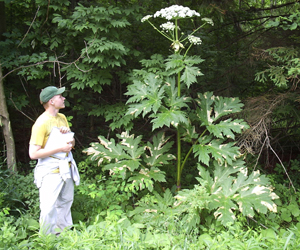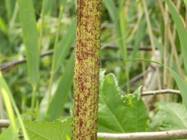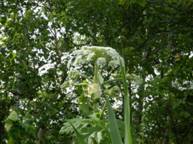News Headlines
-
End of the Road for Greenfield Biomass Project
-
Endangered: Your Local Economy
-
Be Aware – Giant Hogweed
-
The EEA Landscape Partnership Grant Program: Now Accepting Applications to the FY2014 Grant Round
-
Action Alert: Massachusetts House Bills which include Vermont Yankee and Seabrook
-
Sheffield Land Trust Office Space Search!
-
List of GE Pittsfield/Housatonic River Project Documents submitted to Repositories from 6/30/2013 – 7/13/13
-
MEES Conference 2014: Call for Workshop Proposals
End of the Road for Greenfield Biomass Project
The plaintiffs appealing the Greenfield, MA Zoning Board decision to grant a Special Permit for a 47 Megawatt biomass power plant filed a request in the Franklin Superior Court to annul the permit. The request for the Final Judgment came after Cambridge, MA based Matthew Wolfe of Pioneer Renewable Energy allowed a July 16, 2013 deadline to pass. The plaintiffs and the developer had agreed that if an amended permit was not submitted to the Greenfield Planning Board by the deadline, the permit would be annulled.
The permit was issued in July 22, 2009. 450 people attended the permit hearings. Most who spoke were against the project, expressing concerns including questions about the wood supply and negative health and environmental impacts. The project would have burned 600,000 tons of wood each year at the Industrial Park in north Greenfield. The Zoning Board unanimously to approve the plan.
The need for an amended permit resulted from a citizen appeal of a Town Council decision to sell waste water to cool the power plant. Mr. Wolfe withdrew that part of his plan just weeks before the June 2010 vote, declaring the vote a moot point, but the voters decided by an 84% margin to overturn the Town Council decision.
The zoning appeal languished in the court while all sides agreed to wait for the new Massachusetts biomass regulations to become finalized. Those regulations were issued in August, 2012, and placed stricter standards for biomass power generators to receive state subsidies. In March, 2013, all parties in the lawsuit agreed on the July date for the developer to finalize his plans with the town with an amended permit using dry cooling, or the permit would be annulled.
Volunteer group Concerned Citizens of Franklin County along with volunteer regional experts fought the project since it was first proposed. Greenfield businessman Lenny Weeks, whose large outdoor signs at Tire Warehouse on Federal St. provided biomass updates and a place to sign petitions, said “I am proud to be a citizen of a community that really pulled together over the years in our battle with biomass. I saw all walks of life show up and voice their opinions.” For Weeks’ son, Jesse, the news is a relief. “For the last four and a half years, the people of Greenfield and neighboring towns have lived under the specter of an industrial sized biomass incinerator- an anxiety and reality which settled like a pall over all our homes and happiness.”
Lynne Ballard and her husband City Councilman Patrick Devlin live near the project site. “Our lives have been on hold for the past four years, and we know others’ have been as well. We love our home and we love Greenfield. But we felt that we would not have been able to stay if the power plant got built. We are very relieved that, finally, we feel we can stay on our home,” said Ballard.
Glen Ayers is the Regional Health Agent with the Franklin County Cooperative Public Health Service. “This incinerator was a serious public health threat. It’s a great day for people with COPD, asthma, and many other ailments that are exacerbated by our deteriorating air quality. It’s a win for children, infants, and elderly residents who tend to be more sensitive to air pollution.” Ayers said that local Boards of Health had no say in the permitting process, while responsible for protecting local air quality. “The adjacent towns’ Boards of Health weren’t asked for their opinions about this incinerator. When a big polluting industry is proposed for our region, we need a regional discussion and decision. I am overjoyed that this ill-conceived plan been cancelled.”
Mary Booth, Ph.D , Director of the Partnership for Policy Integrity provided a technical reviews of the proposal and the group’s other efforts. “The biomass plant in Greenfield would have been one of the biggest polluters in Western Massachusetts. The withdrawal of the project represents a win for the climate and for public health.”
Chris Matera, founder of MassForestWatch said “Due to the tireless effort of local citizens, biomass is gaining the dirty energy reputation it deserves and being exposed for the deceptive “greenwash” that it is. Now citizens of Greenfield can start looking into genuinely “clean” and “green” energy sources as well as conservation and efficiency.”
“There were a hundred or more volunteers who brought the issues about biomass burning to light in Greenfield, and managed to stop this project.” said Concerned Citizens’ member Janet Sinclair. According to Sinclair, the Greenfield group coordinated efforts with groups from Russell and Springfield. The Russell developers withdrew their proposal for a 50 Megawatt biomass plant in October, 2012 stating that the new biomass regulations made their project financially unfeasible. The plan for a 35 Megawatt wood burning power plant for East Springfield is on hold due to a number of legal appeals, including of decisions by the City Council and the Zoning Board of Appeals.
Endangered: Your Local Economy
from the Schumacher Center for a New Economics
Is there an independent bookstore, a local bike shop, or an old-fashioned camera shop in your community? If so, they need saving as urgently as the Piping Plover or Plymouth Red-Bellied Turtle. To preserve these businesses, we need to preserve their habitat—a habitat of small, locally owned enterprises, trading with one another, welcoming customers by name, paying town taxes, providing secure jobs, donating gift certificates to benefit the Little League Team, and serving on town boards.
BerkShares local currency provides us a way to distinguish and support our Berkshire independent businesses. Alice Maggio’s interviews for the BerkShares Business of the Month series are printed in Berkshire Trade and Commerce and aired on WSBS (both of which are also local businesses.) Her five interviews (links below) allow those at the heart of our economy to speak for themselves.
Protecting an endangered species and restoring its habitat is a task specific to each place and the culture, ecology, and human society of that place. You will have your own approach to preserving your local economy: stories, contests, business alliances, citizen marketing, community financing. Alice’s talk on Community Supported Industry tells about some of these, and in this video she explains how, with BerkShares, we have the potential to reclaim currency as a community economic development tool.
Best wishes,
Staff of Schumacher Center for a New Economics
Be Aware – Giant Hogweed
from our MassDEP Circuit Rider
Do Not Touch This Plant!
Giant hogweed (Heracleum mantegazzianum) is a Federally listed noxious weed. Giant Hogweed has been identified in: Alford, Blandford, Becket, Chester, Lee, West Stockbridge, Monterey, Huntington-just to name a few. Its sap, in combination with moisture and sunlight, can cause severe skin and eye irritation, painful blistering, permanent scarring and blindness. Contact between the skin and the sap of this plant occurs either through brushing against the bristles on the stem or breaking the stem or leaves.
What to do if you come in contact with giant hogweed:
This plant poses a serious health threat; see your physician if you think you have been burned by giant hogweed. If you think you see giant hogweed, do NOT touch it. But if you are in Massachusetts, do report it here (http://massnrc.org/pests/hogweedreport.aspx).
When giant hogweed sap, which contains photosensitizing furanocoumarins, contacts human skin in conjunction with sunlight, it can cause phytophotodermatitis – a serious skin inflammation. In brief, the sap prevents your skin from protecting itself from sunlight which leads to a very bad sunburn. Heat and moisture (sweat or dew) can worsen the skin reaction. The phototoxic reaction can begin as soon as 15 minutes after contact, with sensitivity peak between 30 minutes and two hours after contact.
What are the symptoms of exposure to giant hogweed sap?
· Painful blisters that form within 48 hours and become dark and pigmented
· Scars that last up to six years, though typically only last a few months
· Long-term sensitivity to sunlight is common
· Blindness may occur if the sap gets into the eye
How do you identify giant hogweed?
Giant hogweed is a biennial or perennial herb in the carrot family (Apiaceae) which can grow to 14 feet or more. Its hollow, ridged stems grow 2-4 inches in diameter and have dark reddish-purple blotches. Its large compound leaves can grow up to 5 feet wide. It’s white flower heads can grow up to 2 1/2 feet in diameter.
Where is giant hogweed found?
Giant hogweed is a native of the Caucasus Mountain region between the Black and Caspian Seas. It was introduced to Europe and the United Kingdom in the late nineteenth century and to the United States in the early twentieth century as an ornamental garden plant. It has become established in New York, Pennsylvania, Ohio, Maryland, Oregon, Washington, Michigan, Virginia, Vermont, New Hampshire and Maine. Seeds may also be distributed by birds and waterways, and can remain viable for over 10 years.
More about Giant Hogweed:
Giant Hogweed Identification – This page has photos of all parts of the giant hogweed plant as well as photos of common lookalike plants for identification purposes.
Health Hazards & Safety Instructions for Giant Hogweed (with graphic photos) – This page describes the health hazards of giant hogweed and details how people should protect themselves against the harmful sap.
How To Control Giant Hogweed – A variety of methods for controlling this non-native invasive plant.
NYSDEC Giant Hogweed Control Program – Details the statewide giant hogweed control program protocol.
Giant Hogweed Statewide Distribution Map – Statewide distribution and density of giant hogweed sites by county.
Giant Hogweed Eliminated Sites Map – Sites that previously had giant hogweed. These sites were treated and no longer have giant hogweed.
Giant Hogweed Biology – This page describes the biology of giant hogweed plants to include their growth and development stages, seed dispersal and viability, as well as the habitat and competition for giant hogweed plants
USDA http://www.invasivespeciesinfo.gov/plants/hogweed.shtml
The EEA Landscape Partnership Grant Program: Now Accepting Applications to the FY2014 Grant Round
The Mass. Executive Office of Energy and Environmental Affairs (EEA)’s Division of Conservation Services (DCS)’s Landscape Partnership Program seeks to preserve large, unfragmented, high-value conservation landscapes including working forests and farms, water supply, and conservation lands. It is intended to promote government-municipal-private partnerships, enhance stewardship of conservation land, and provide public recreation opportunities. The program offers competitive grants to municipalities, non-profit organizations, and EEA agencies acting cooperatively to permanently protect a minimum of 500 acres of land.
Maximum grant award: $1.5 million
Reimbursement rate: up to 50%
Application deadline: Thursday, October 10, 2013
Information sessions:
Tuesday, August 20 2:00 pm
Department of Conservation and Recreation
136 Damon Rd
Northampton, MA
Tuesday, August 27, 11:00 am
Boston EEA office
100 Cambridge St, 9th floor
Boston
Contact: Celia Riechel, Massachusetts Executive Office of Energy and Environmental Affairs
617-626-1187
Action Alert: Massachusetts House Bills which include Vermont Yankee and Seabrook
These bills need your support, please contact your legislator:
HOUSE 1906: An Act increasing nuclear power plant protections to a twenty mile radius.
HOUSE 1907: An Act to amend Section 5K(E) of Chapter 111.
HOUSE 2045: An Act increasing nuclear power plant protections to a twenty mile radius.
HOUSE 2046: An Act relative to radiological air monitoring.
For more info see our website: http://www.nukebusters.org
Sheffield Land Trust Office Space Search!
Hi Friends of the Sheffield Land Trust,
The Land Trust is looking for a new home. Tatkon House, where we have shared offices with The Nature Conservancy for over 10 years, has been sold due to reductions in The Nature Conservancy’s staff and other changes in their organization. Although we would have liked to remain at Tatkon House, the expense of doing so makes it unrealistic. We have to vacate Tatkon House by mid-September.
We are looking for office space to rent or buy. We need 1,200-1,500 square feet. It would have at least three rooms suitable for offices (or space that could be divided), a larger room for meetings, a bathroom, and storage space (preferably on the first floor). The location, in Sheffield, must have high-speed Internet availability and be adaptable for air-conditioning. On a daily basis we’ll need parking for 3-4 cars, however, about twice per month during meetings we’ll need space for about 12 cars. We have some leads through the usual real estate channels, but we are asking our friends in case someone knows of unadvertised available space.
If you have information or ideas, please contact us at 413-229-0234 or shefland@bcn.net.
Thanks for your help!
Sheffield Land Trust
PO Box 940, Sheffield, Massachusetts 01257
413-229-0234; shefland@bcn.net
List of GE Pittsfield/Housatonic River Project Documents submitted to Repositories from June 30, 2013 through July 13, 2013
Documents submitted to the Berkshire Athenaeum
Letter from David Dickerson (USEPA) to Richard Gates (GE), July 1, 2013, Re: Approval of GE’s 5-21-13 Re-submittal of Revised Evaluations for Recreational Areas RA-2, RA-3 and RA4, Silver Lake Area, GE-Pittsfield/Housatonic River Site
Letter (with attachments) from Richard W. Gates (GE) to Richard Fisher (USEPA), July 1, 2013, Re: GE-Pittsfield/Housatonic River Site; East Street Area 2-South (GECD150); Summary of May 2013 Inspection Activities
Letter from David Dickerson (USEPA) to Richard Gates (GE), July 2, 2013, Re: Approval of GE’s 5-21-13 Re-submittal of Revised Evaluations for Bank Portions of Tax Parcels I9-9-17, I99-18, I9-9-19, and I9-9-201, Silver Lake Area, GE-Pittsfield/Housatonic River Site
Letter from Richard W. Gates (GE) to Dean Tagliaferro (USEPA), July 2, 2013, Re: GE-Pittsfield/Housatonic River Site (GECD900); Revised Field Sampling Plan/Quality Assurance Project Plan, Project Operations Plan, and Site Health and Safety Plan
Letter (with attachments) from Richard W. Gates (GE) to Richard Fisher (USEPA), July 2, 2013, Re: GE-Pittsfield/Housatonic River Site; Groundwater Management Area 5 (GECD350); Proposal to Decommission Monitoring Wells
Letter (with attachments) from Richard W. Gates (GE) to Richard Fisher (USEPA), July 3, 2013, Re: GE-Pittsfield/Housatonic River Site; East Street Area 2-North (GECD140); Summary of June 2013 Inspection Activities
Letter (with attached report) from Richard W. Gates (GE) to Michael Gorski (MADEP), July 8, 2013, Re: June 2013 Monthly Status Report; GE Pittsfield ACO/MCP Activities
Letter (with attached report) from Richard W. Gates (GE) to Dean Tagliaferro (USEPA) and Michael Gorski (MADEP), July 9, 2013, Re: GE-Pittsfield/Housatonic River Site; Monthly Status Report Pursuant to Consent Decree June 2013 (GECD900)
Letter from David Dickerson (USEPA) to Andrew Silfer (GE), July 10, 2013, Re: Response to GE’s July 10, 2013 Proposed Corrective Measures for Low TOC Areas for Silver Lake Sediment Cap
Letter (with attachments) from Richard W. Gates (GE) to Dave Dickerson (USEPA), July 11, 2013, Re: GE-Pittsfield/Housatonic River Site; Silver Lake Area (GECD600); Re-evaluation of Bank Portions of Tax Parcels I9-9-1, I9-9-9, and I9-10-8
Letter (with attachment) from Richard W. Gates (GE) to Dean Tagliaferro (USEPA), July 12, 2013, Re: GE-Pittsfield/Housatonic River Site (GECD900); Errata to Revised Project Operation Plan – July 2013
Documents submitted to the Connecticut Repositories
Letter (with attached report) from Richard W. Gates (GE) to Dean Tagliaferro (USEPA) and Michael Gorski (MADEP), July 9, 2013, Re: GE-Pittsfield/Housatonic River Site; Monthly Status Report Pursuant to Consent Decree June 2013 (GECD900
MEES Conference 2014: Call for Workshop Proposals
Environmental Literacy for the Next Generation
Wednesday, March 5, 2014
College of the Holy Cross
Worcester, MA
The Massachusetts Environmental Education Society (MEES) is seeking workshop proposals for the 2014 Conference: Environmental Literacy for the Next Generation.
For more than thirty years, the MEES conference has attracted participants with great presentations, great exhibits and great conversation! The conference draws a diverse audience including classroom teachers from pre-school to college, museum and nature center staff and administrators, and community resource leaders. We hope you will consider presenting at this exciting conference!
This year MEES welcomes proposals related to the theme Environmental Literacy for the Next Generation. As environmental education gains more and more traction in the academic world, with Environmental Literacy Plans written for almost every New England state and classroom teachers bringing the outdoors into their classrooms, there is a greater need for environmental literacy resources, programs, and strategies for integration. This conference also comes at a time when the Next Generation Science Standards have been released and are ready for implementation.
Based on member input, the 2014 MEES Conference will use descriptive strands as a way to identify workshops more easily and effectively. Read on to discover where your presentation fits!
Classroom Teachers (CT): Do you incorporate the outdoors into your classroom? Do you have creative and engaging resources to incorporate the environment into STEM standards? Does your school utilize an outdoor classroom? Do you use the environment as a way to teach cross-curricular topics?
Environmental/Outdoor Educators (EOE): Are you an expert in a specific field, for example: birding, tracking, identification, team building, nature writing, storytelling… you name it! Do you work with schools? How do you interpret climate change with your audience? Do you have a successful resource to connect your audience to the natural world?
Administrator (A): How is your organization working to incorporate climate change? Has your organization “gone green”? Do you have an innovative marketing technique? Have you successfully utilized social media? Do you have creative solutions to working in a funding constrained environment?
Non-Strand (NS): Please submit a non-strand presentation if you don’t find a good match! We encourage diversity in the conference presentations!
*Special consideration will be given to those workshops that contain “hands-on” materials and activities that participants can take with them to share with co-workers.
*For workshops geared towards classroom teachers in the audience, please refer to the “Guidelines for K-12 Professional Development” at the end of this email, as adapted from the Massachusetts Department of Education.
Join us in promoting and supporting environmental education in Massachusetts!
To submit a proposal: Click here and fill out the online Conference Workshop Proposal Form.
The deadline for submission is September 15, 2013.
Guidelines for K-12 Professional Development
- Connections to Common Core of Learning and state Curriculum Frameworks.
- Plan professional development with clear objectives, relevant learning activities and conclusions.
- Incorporate technology tools and appropriate media.
- Build on educators’ prior knowledge and experience.
- Use principles of adult learning theory to engage educators in professional growth.
- Depth of content rather than breadth of information presented.
- Employ a variety of teaching techniques such as direct instruction, practice, discussion, problem-solving, Socratic dialogue, and research projects
- Provide many and varied opportunities for educators to incorporate new knowledge and skills into classroom practice or school and district management.
- Assess proficiency through an appropriate end-of-course assessment.
- Provide follow-up resources.
Email agisinger@massmees.org with questions!






